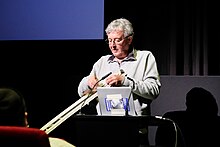Peter Tscherkassky (born October 3, 1958) is an Austrian avant-garde filmmaker[1] who works primarily with found footage. All of his work is done with film and heavily edited in the darkroom, rather than relying on recent advances in digital film.

Early life
editTscherkassky was born October 3, 1958, in Vienna, Austria. He attended the Primary School in Mistelbach from 1965 to 1969 and Jesuit boarding school from 1969 to 1975 in Vienna. He attended BORG (high school) Mistelbach and graduated in June 1977. From 1977 to 1979 Tscherkassky studied journalism and political science as well as philosophy at the University of Vienna. His first encounter with avant-garde film was in January 1978 when he attended a five-day lecture series by P. Adams Sitney at the Austrian Film Museum.
Film career
editTscherkassky began filming in 1979 when he acquired Super-8 equipment and before the end of the year he had scripted and started off the shooting of Kreuzritter. Throughout his career he conceived numerous film festivals, including “The Light of Periphery: Austrian Avant-Garde Film, 1957–1988” (1988), “Im Off der Geschichte” (1990), “Found Footage: Filme aus gefundenem Material” (1991), and “Unknown Territories: The American Independent Film” (1992). He was also the founding member of the newly Austria Filmmakers Cooperative which began in 1982 and resigned from his position there in 1993. His work Instructions for a Light and Sound Machine (2005) had its world premiere at the Cannes Film Festival in the series "Quinzaine des réalisateurs."
Filmography
edit- Bloodletting (1981)
- Erotique (1982)
- Love Film (1982)
- Freeze Frame (1983)
- Holiday Movie (1983)
- Miniaturen: Many Berlin Artists in Hoisdorf (1983)
- Motion Piction (1984)
- Manufracture (1985)
- Kelimba (1986)
- Shot Countershot (1987)
- Tabula Rasa (1987/89)[2]
- Parallel Space: Inter-View (1992)
- Happy-End (1996)
- L'Arrivée (1997/98; using footage from L'Arrivée d'un train en gare de La Ciotat (1896) by the Lumiere Brothers and Mayerling (1968) by Terence Young)[3]
- Outer Space (1999; using footage from The Entity (1982) by Sidney J. Furie)[4][5][6]
- Get Ready (1999)
- Dream Work (2001; using the same film as Outer Space)
- Instructions for a Light and Sound Machine (2005; using footage from The Good, The Bad and The Ugly (1967) by Sergio Leone)[7]
- Nachtstück (Nocturne) (2006)
- Coming Attractions (2010)
- The Exquisite Corpus (2015)
- Train Again (2021)
See also
edit- Martin Arnold - closely associated with Tscherkassky
- Cinephilia
Notes
edit- ^ Interviews: Tscherkassky and Heller and More|Current|The Criterion Collection
- ^ A CONVERSATION WITH PETER TSCHERKASSKY AND EVE HELLER — destifilm
- ^ Lost Material and Found Footage: Peter Tscherkassky's Dark Room - And Ours - Jonathan Rosenbaum
- ^ 25 Of The Best Short Films You Can Watch Online - Page 3 - Taste of Cinema
- ^ How Peter Strickland Discovered Peter Tscherkassky on Notebook|MUBI
- ^ You Give Me Fever - The Village Voice
- ^ CLOSE-UP|Instructions for a Light and Sound Machine
References
edit- Articles about Tscherkassky on Senses of Cinema
- Alexander Horwath, Michael Loebenstein (Ed.): Peter Tscherkassky, FilmmuseumSynemaPublikationen Vol. 2, Vienna 2005, ISBN 3-901644-16-4
- Dossier on Peter Tscherkassky by Matt Levine, Jonathan Rosenbaum and Virgil Widrich (César Ustarroz, ed.), in Found Footage Magazine, issue#4, 2018. ISSN 2462-2885.